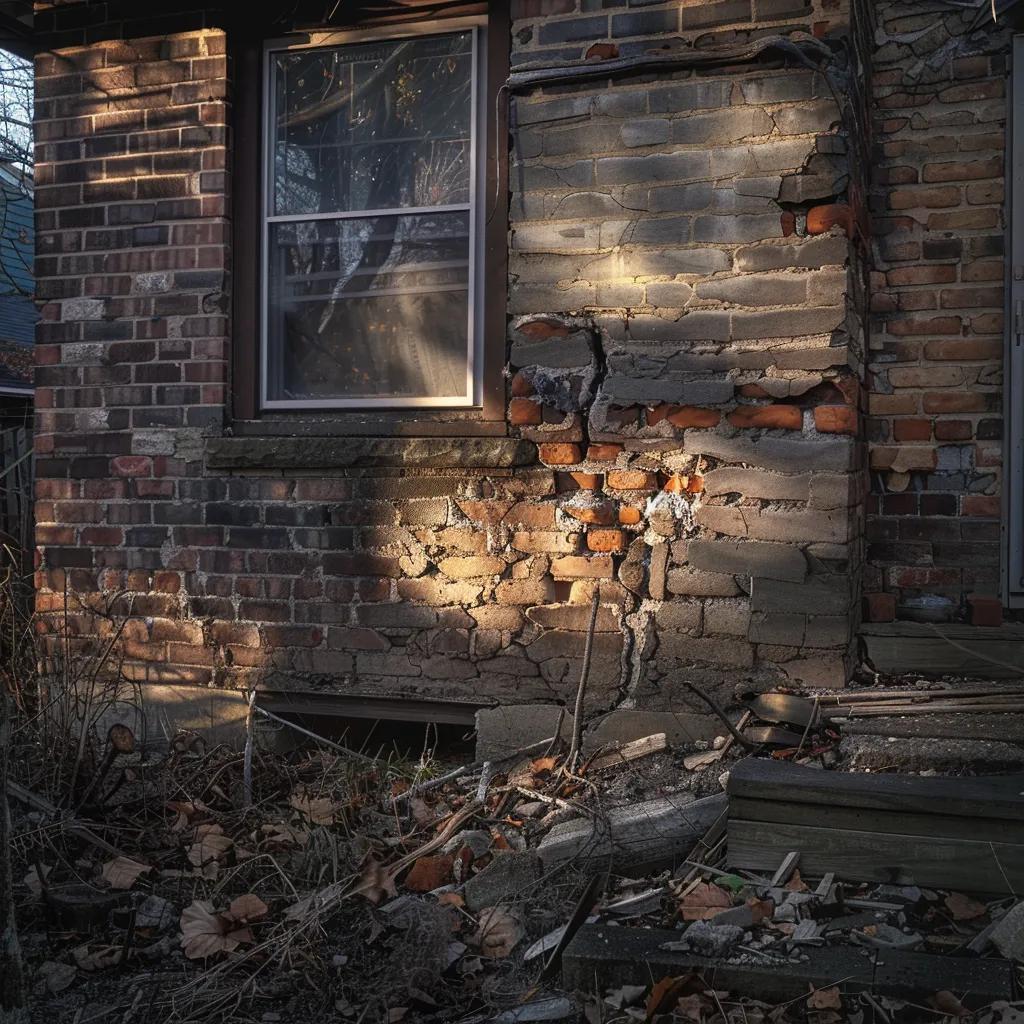Is Your Home’s Value at Risk? Signs to Watch For
An aging home or one built on unstable soil faces significant foundation issues if early warning signs are ignored. Cracks in walls, uneven floors, or sticking doors can lead to expensive repairs. This article outlines the key indicators that your home may need foundation repair, explains how these issues affect property value, and describes the steps to protect your investment through professional evaluation and timely action.
Transitioning now to an in-depth look at the essential signs and symptoms that alert you to foundation damage.
Recognizing Telltale Indicators Your Home Needs Foundation Repair
Foundation problems often appear subtly before escalating. Early detection can prevent minor issues from developing into major repairs.
Identify Cracks in Walls and Ceilings That Signal Foundation Trouble
Cracks in walls and ceilings are among the first signs of foundation failure. Fine hairline fractures at the base of walls may widen or increase in number due to shifting stresses in the concrete or wood framing from soil movement or erosion. Vertical cracks can be benign; however, horizontal or stair-step cracks are worrisome. Homeowners should monitor these changes closely as they can indicate imminent structural problems.
Notice Uneven or Sloping Floors Pointing to Foundation Shifts
Uneven floors or a noticeable slope in flooring may signal that the underlying support has shifted. This can cause instability in furniture and affect the movement of objects. Even minor variations in floor level can stress structural beams and joists over time. Regular, precise level assessments help detect these shifts early, potentially preventing further damage.
Observe Doors and Windows That Stick or Fail to Close Properly
Sticking doors and windows often reflect a misaligned frame caused by foundation settlement. When the structure shifts, door frames and window sills may become misaligned. Instead of simply adjusting hardware, it is important to have a professional foundationinspection, as these signs show that the home’s overall structure may be warping.
Spot Gaps Appearing Between Walls and Ceilings or Floors
Gaps between walls and ceilings or between floors suggest that the home is settling unevenly. These gaps not only hurt the aesthetic appeal and insulation integrity but also serve as physical evidence of uneven load distribution. If gaps begin to appear or widen, it is a clear sign to document the changes and seek a professional assessment to check for underlying foundation issues.
Detect Bowing or Leaning Basement Walls Indicating Pressure
Bowing or leaning basement walls are among the most alarming indicators of foundation distress. Increased soil pressure—often from excess water or swelling clay—can force basement walls to bow inward. Even a slight bow may rapidly worsen if water pooling or erosion persists. Immediate remedial measures, such as waterproofing and reinforcement, are typically recommended to stabilize the structure.
How Foundation Problems Directly Diminish Your Property’s Worth

A home’s foundation is critical to its overall market value. Problems in the foundation lower appraisals and deter potential buyers.
Understand the Reduction in Market Value Due to Foundation Flaws
When foundation issues are present, appraisers reduce a home’s value to reflect the cost of repairs. Defects may lower market value by 10–20% due to repair estimates and ongoing maintenance risks. This initial devaluation can worsen over time if the issue is not corrected.
Acknowledge Lower Buyer Interest When Foundation Issues Are Present
Buyers are naturally cautious of homes with foundation troubles because they face the risk of future repairs. Many buyers request discounts or credits upon discovering such defects, and lower interest may force sellers to reduce listing prices, further decreasing property value.
Anticipate Lower Appraisal Values From Inspectors Identifying Foundation Damage
Professional inspectors routinely identify foundation issues during appraisal. Even minor defects can lead to a reduction in appraisal value by 10–15%, which in turn affects financing options and overall equity.
Prepare for Negotiation Challenges and Reduced Offers
Foundation problems weaken a seller’s negotiating position. Buyers often use the cost of necessary repairs as a bargaining chip, resulting in lower offers and longer time on the market. Quick action to repair the foundation helps avoid these negotiation challenges.
Realize the Potential for an Extended Time on the Market
Homes with foundation issues often remain unsold longer than those with sound structures—sometimes up to 40% longer. Extended market time can further erode property value, as buyers assume additional underlying issues may exist.
Exterior Warning Signs of Potential Foundation Distress
The exterior of the home can reveal early signs of foundation trouble before interior issues become apparent.
Examine Cracks in the Visible Foundation or Brickwork
Visible cracks in masonry or brickwork near the foundation signal structural stress. Cracks wider than 1/4 inch warrant further evaluation. The pattern and direction of these cracks help distinguish between surface settling and deeper issues.
Check for a Tilting or Leaning Chimney
A chimney that tilts away from the vertical indicates uneven settling. Since the chimney is part of the foundation system, even a slight lean can signal broader structural issues. Professional assessment is advised when a chimney shows such misalignment.
Inspect Siding for Warps or Cracks
Warping or cracking of exterior siding, whether wood, vinyl, or fiber cement, suggests the underlying structure is shifting. Such damage may also allow moisture ingress, leading to wood rot and mold growth. Regular checks can help catch these issues early.
Look for Water Pooling Around the Home’s Foundation
Pooling water near the foundation can build hydrostatic pressure against foundation walls, causing cracks or spalling. Poor drainage increases the risk of water damage. Homeowners should ensure that gutters and downspouts are directing water away from the home and consider professional waterproofing if pooling persists.
Notice Soil Pulling Away From Foundation Walls
Soil that begins to recede from the foundation is a clear warning sign. This gap, caused by erosion or inadequate drainage, diminishes the support around the foundation walls. Corrective landscaping or regrading may be necessary to restore proper support and protect the foundation.
Interior Clues That Your Foundation May Require Attention
Interior signs of foundation distress often prompt homeowners to seek professional help before problems worsen.
Find Sagging or Springy Floors Over Crawlspaces
Floors that feel saggy or unusually springy suggest that the foundation is settling unevenly. In older homes, weakened joists or subflooring can exacerbate this issue. A thorough inspection of the crawlspace can confirm whether reinforcement or repairs are necessary.
Discover Cracked Floor Tiles or Wood Flooring Issues
Cracked or displaced floor tiles and gaps in wooden flooring are red flags that the foundation may be shifting. Over time, such damage can compromise safety. Addressing these issues promptly may prevent further deterioration of both the flooring and the foundation.
Identify Nails Popping Out of Drywall
When nails or screws pop from drywall, it can indicate that wall framing is moving due to foundation shifts. This recurring issue should prompt a detailed inspection to uncover any hidden structural problems.
Notice a Musty Odor or Mold Growth in the Basement or Crawl Space
Persistent musty odors or visible mold in basements or crawl spaces are often signs of water intrusion through a compromised foundation. Such conditions not only damage building materials but may also pose health risks. Immediate measures to improve waterproofing and remove moisture are critical.
Observe Water Damage or Dampness in Lower Levels
Water stains, damp spots, and persistent humidity in lower areas of the home signal that water is seeping through the foundation. This can damage finishes, promote rust in fixtures, and weaken structural components. Professional moisture readings can help determine the extent of the problem.
The Financial Repercussions of Ignoring Foundation Repair Needs
Foundation issues can lead to escalating repair costs and reduced property value, affecting both sale price and financing options.
Calculate the Escalating Cost of Delayed Foundation Repairs
Neglected foundation issues tend to worsen over time, leading to more extensive and expensive repairs later. Early intervention typically costs a fraction of what extensive repairs might require, helping to prevent compounded structural damage.
Consider the Impact on Securing Home Financing or Insurance
Lenders and insurers view foundation defects as significant risks. A home with unresolved issues may result in lower loan amounts, higher interest rates, or increased insurance premiums. Addressing these problems early can secure better financing terms and insurance coverage.
Understand Legal Disclosure Requirements When Selling
Many jurisdictions require sellers to disclose known foundation issues. Failure to do so can lead to legal disputes or canceled sales. Proper documentation of repairs and inspections protects sellers and reassures buyers.
Recognize That Unaddressed Issues Can Deter Potential Buyers
Even minor foundation issues can dissuade buyers, who may fear additional hidden defects. Lower buyer interest often forces sellers to reduce prices or endure lengthy negotiations.
Appreciate That Timely Repairs Can Preserve Home Value
Investing in prompt foundation repair can stop depreciation and help retain market value. A well-documented repair process builds buyer confidence, contributing to a quicker sale at a fair price.
Taking Action When You Suspect Foundation Damage Threatens Home Value
Timely action not only protects the structure but also helps maintain the home’s market appeal and financial stability.
Schedule a Professional FoundationInspection for an Accurate Assessment
The first step is to have a comprehensive inspection by a qualified foundation repair specialist. Using tools like laser levels and moisture meters, inspectors determine the extent of damage. Their detailed report guides the necessary repair measures.
Obtain Estimates for Necessary Foundation Repair Work
After the inspection, gather repair estimates from certified contractors. Comparing quotes helps ensure transparency, competitive pricing, and that all required work—from underpinning to waterproofing—is covered. Detailed estimates are also valuable for future resale.
Evaluate if Repairing Before Selling Is the Best Strategy
Homeowners must decide whether to repair before selling or to sell the home “as-is.” While repairs require upfront investment, they typically result in a higher sale price and faster market acceptance. Correcting foundation issues can reduce lengthy negotiations and lower buyer contingencies.
Understand Options for Selling a House With Known Foundation Issues
If immediate repairs are not feasible, sellers should disclose all issues and adjust the listing price to reflect necessary repairs. Working with buyers experienced in rehabilitating distressed properties can also streamline the sale process.
Keep Detailed Records of All Inspections and Repairs Undertaken
Comprehensive documentation—including receipts, inspection reports, and contractor warranties—builds buyer confidence and supports higher resale values. Organized records simplify the disclosure process and protect against future disputes.
Table: Financial Impact of Foundation Issues and Repairs
Below is a table summarizing the potential financial impacts of unresolved foundation issues versus timely repairs:
This table clearly shows how addressing foundation issues early can preserve overall property investment and financial stability.
Frequently Asked Questions
Q: What specific cracks should prompt a professional inspection? A: Cracks wider than ¼ inch, especially if horizontal or stair-step, are strong indicators of foundation damage. When such cracks appear or worsen, a professional inspection is recommended.
Q: Can uneven floorsbe solely attributed to foundation problems? A: While several factors can cause uneven floors, when they appear with wall cracks and sticking doors, it typically suggests foundation settlement. A structural engineer should evaluate these signs.
Q: How do exterior water pooling and soildisplacement affect foundationintegrity? A: Water pooling increases hydrostatic pressure, leading to cracks and destabilization, while soil pulling away from the foundation reduces support. Both conditions heighten the risk of structural damage.
Q: Are cosmetic repairs sufficient to address foundation damage? A: Cosmetic fixes only mask symptoms and do not correct underlying structural problems. A full assessment and proper repair—such as underpinning or pier installation—is necessary.
Q: How often should a homeowner schedule foundationinspections? A: Professional inspections are recommended every 3–5 years, or immediately after severe weather events or noticeable structural changes.
Q: Can foundation repairincrease the resale value of my home? A: Yes, repairing the foundation restores structural integrity, which improves market appraisal values and can lead to a quicker sale at a fair price.
Q: What role does proper drainage play in preventing foundation issues? A: Effective gutter systems, downspouts, and proper grading direct water away from the foundation, reducing hydrostatic pressure and soil erosion, which in turn helps maintain foundation integrity.
Final Thoughts
Foundation health is essential to your home’s overall safety and value. Recognizing early signs through both interior and exterior indicators allows homeowners to act promptly, ultimately protecting their investment and ensuring long-term financial stability. By scheduling professional inspections, obtaining detailed repair estimates, and keeping thorough records, you can address foundation issues before they become a major burden.


